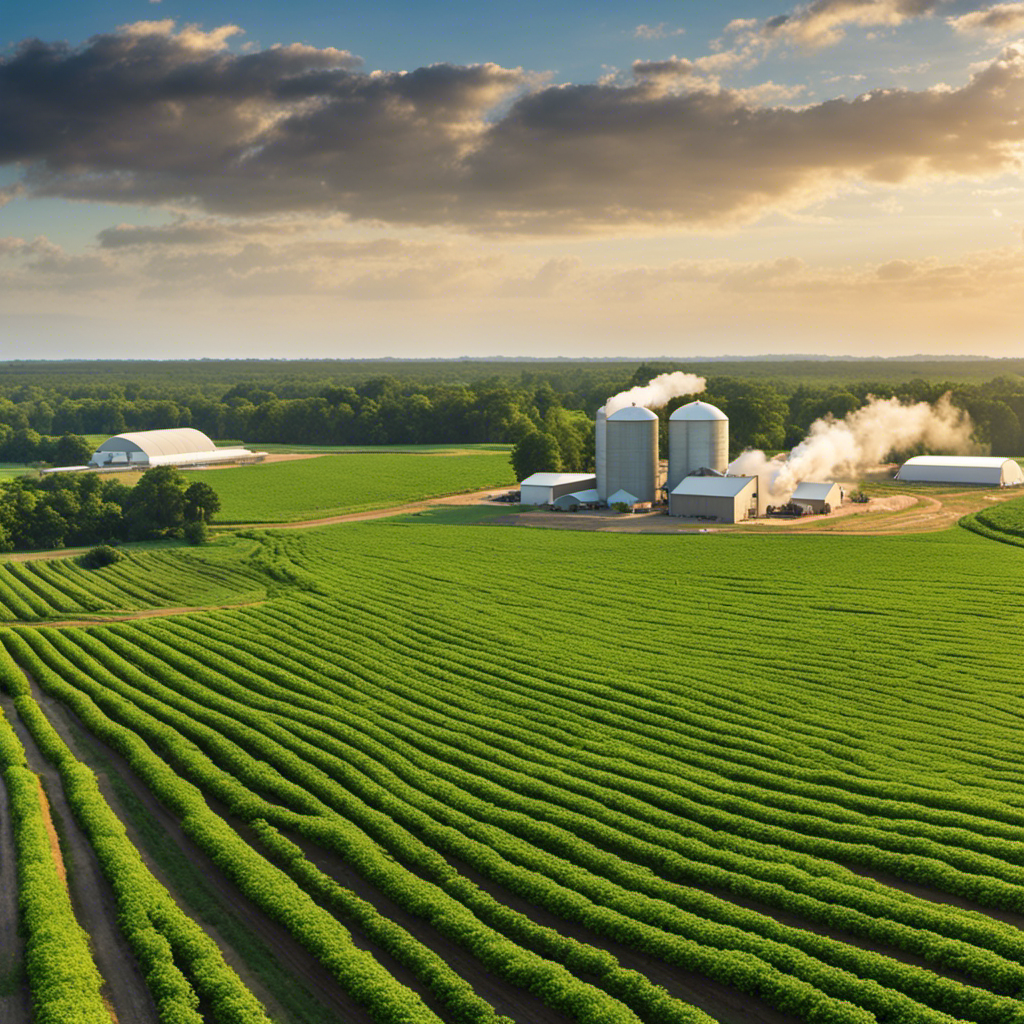To promote sustainability in butter plants, you can repurpose waste cream by turning it into products like ice cream or sour cream, or use it for biogas production, which provides renewable energy for your facility. Proper storage and quality control prevent spoilage and adulteration, minimizing waste. You can also incorporate waste cream into animal feed to improve livestock nutrition. Exploring innovative separation methods and eco-friendly practices helps maximize resources and reduce environmental impact—discover more ways to optimize your operations.
Key Takeaways
- Proper storage and quality testing prevent spoilage and adulteration of waste cream, ensuring safety and sustainability.
- Repurposing waste cream into products like ice cream, cheese, or biogas reduces disposal and promotes resource efficiency.
- Converting waste cream into biogas supports renewable energy generation, lowering reliance on fossil fuels.
- Incorporating waste cream into animal feed enhances livestock nutrition and productivity, minimizing waste.
- Utilizing waste cream reduces environmental impact, cuts costs, and meets market demand for sustainable, high-quality dairy products.
Understanding Waste Cream in Butter Production
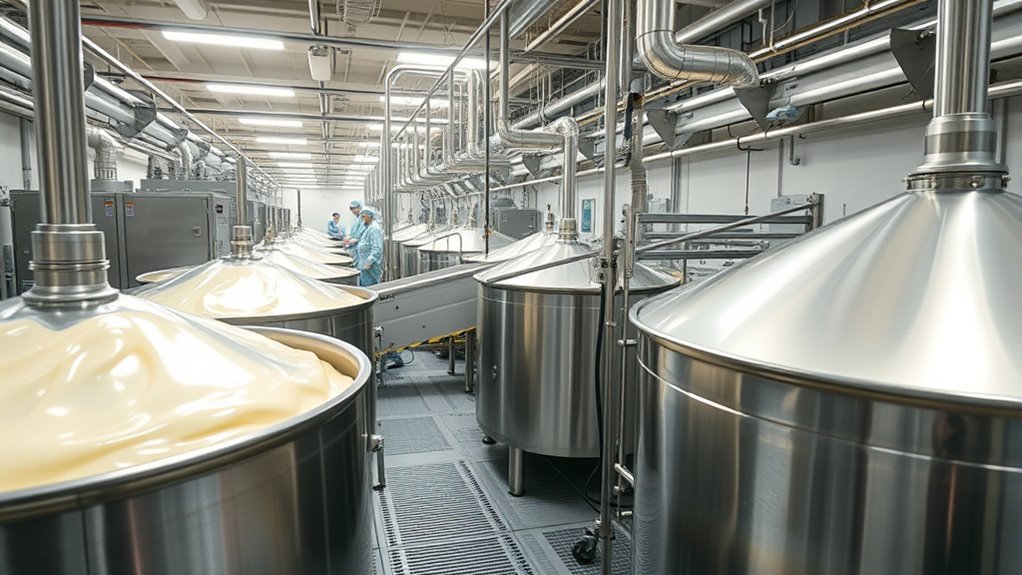
Have you ever wondered what happens to the cream left over during butter production? This excess cream, often considered waste, can be prone to cream spoilage if not handled properly. Spoiled cream leads to quality issues and potential safety concerns. Additionally, cream adulteration is a serious problem; some producers might add foreign substances to increase quantity or alter fat content, compromising product integrity. Proper management guarantees that leftover cream doesn’t become a source of contamination or adulteration, helping maintain high standards in dairy processing. Recognizing proper storage procedures is essential to prevent spoilage and ensure quality. By identifying the causes of cream spoilage and adulteration, you can reduce waste and improve overall efficiency in butter production.
Methods for Repurposing Excess Cream
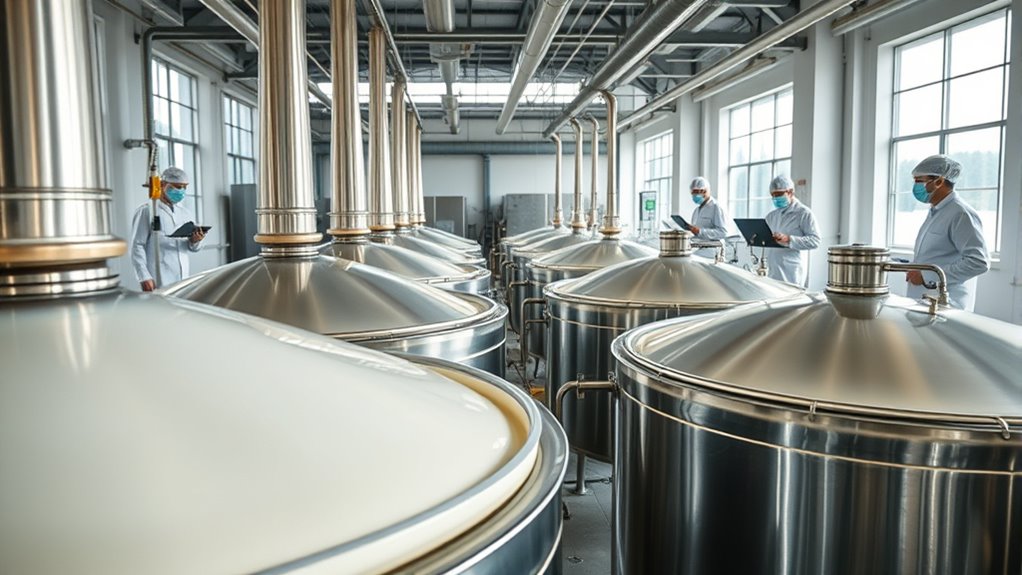
When excess cream cannot be used directly in butter production, there are several effective methods to repurpose it, maximizing its value and minimizing waste. First, you can process the cream into dairy products like ice cream, cream cheese, or sour cream. Proper quality testing guarantees the cream’s freshness and safety, preventing issues related to cream spoilage. Regular testing checks for microbial contamination and spoilage indicators, allowing you to make informed decisions about its suitability for various applications. If cream spoilage is detected, it should be diverted to alternative uses or disposal, avoiding quality issues in final products. Additionally, employing quality control measures helps ensure the safety and freshness of the cream throughout processing. These methods help you reduce waste, optimize resource use, and maintain high product quality standards, supporting sustainability in your butter plant’s operations.
Fermentation and Biogas Production From Waste Cream
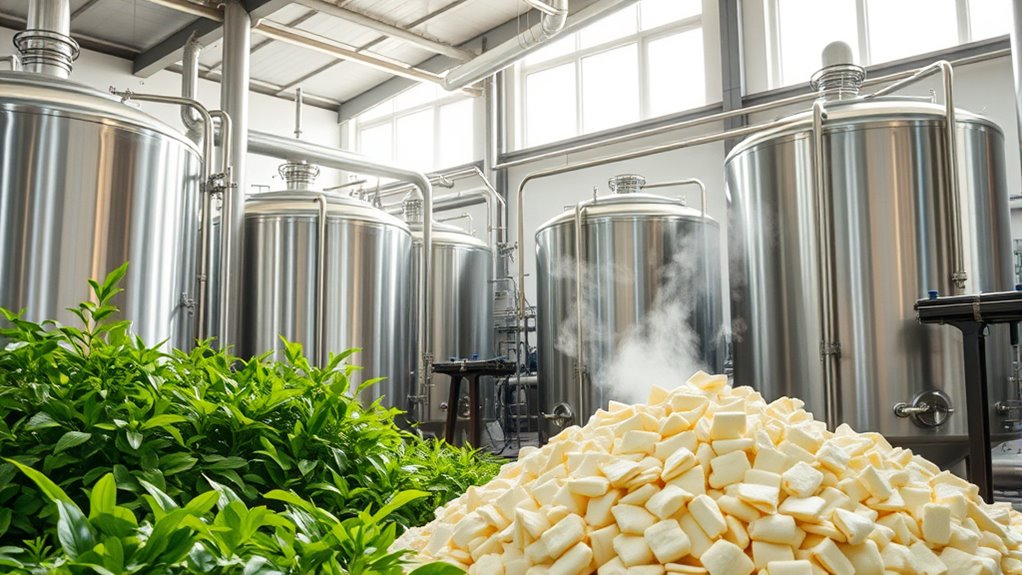
You can optimize the fermentation process to turn waste cream into biogas efficiently. By adjusting key parameters, you’ll maximize energy output and reduce processing time. This approach not only benefits the environment but also provides a sustainable energy source for your needs. Additionally, monitoring fermentation parameters ensures consistent and high-quality biogas production.
Fermentation Process Optimization
Optimizing the fermentation process is essential for maximizing biogas production from waste cream. To do this effectively, you need to focus on key factors influencing microbial fermentation. Here are three critical steps:
- Adjust substrate-to-inoculum ratios to improve microbial activity.
- Fine-tune operational parameters like temperature and pH for ideal microbial growth.
- Scale the process carefully, considering process scaling challenges to maintain efficiency.
- Monitoring microbial populations throughout the process can help identify potential issues and improve overall biogas yields.
Biogas Energy Benefits
Have you ever considered how waste cream can be transformed into a valuable energy source? Fermentation of waste cream produces biogas, which offers significant benefits. This biogas can be used for cooking, heating, or electricity generation, reducing reliance on fossil fuels. You can enhance biogas production by integrating algae cultivation systems, which help improve the fermentation process and manage waste more sustainably. Additionally, coupling biogas plants with solar panel integration maximizes renewable energy use, making your operations more eco-friendly. Using waste cream for biogas not only cuts waste disposal costs but also generates a clean energy source that supports sustainability goals. This approach creates a circular system, turning waste into a resource and reducing your environmental footprint. Incorporating payment solutions into your operations can further streamline processes and support sustainable management practices.
Incorporating Waste Cream Into Animal Feed
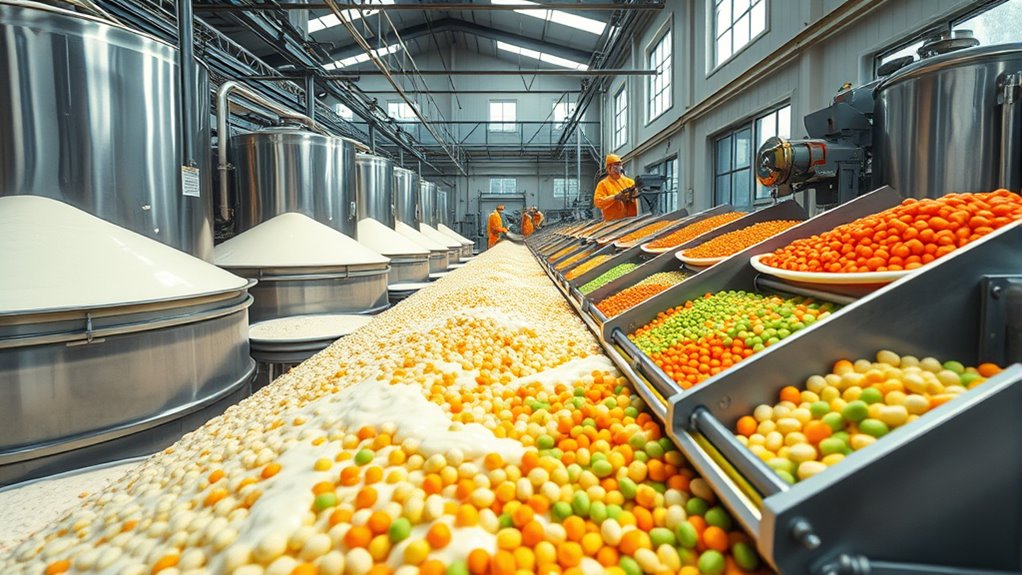
Incorporating waste cream into animal feed can boost livestock nutrition by providing essential fats and proteins. However, you’ll need to address processing challenges to guarantee the cream is safe and easy to handle. Storage issues, like spoilage and contamination, also require careful management to make this practice practical. Implementing proper storage practices can help maintain the quality and safety of waste cream used in feed.
Nutritional Benefits for Livestock
Waste cream can be a valuable addition to livestock feed because of its rich nutrient profile. Its nutritional benefits support livestock health by providing essential fats, proteins, and energy. Including waste cream in feed can improve growth rates and overall productivity. Here are three key benefits:
- Enhanced Energy Intake – The high fat content supplies concentrated energy, reducing feed costs.
- Improved Milk Production – Nutrients from waste cream boost milk yield and quality in dairy animals.
- Better Livestock Health – Healthy fats support immune function and reproductive performance.
Processing and Storage Challenges
While waste cream offers notable nutritional advantages for livestock, integrating it into feed presents several processing and storage hurdles. Proper handling requires efficient storage bins to prevent spoilage and contamination. Maintaining ideal temperature control is vital; if the cream gets too warm, it can ferment or turn rancid quickly. Consistent cooling slows microbial growth and extends shelf life. Additionally, managing moisture levels is essential to avoid spoilage during storage. Processing waste cream into animal feed involves homogenization and proper mixing, which can be complicated by its high-fat content. Ensuring the storage environment remains clean and temperature-regulated helps preserve nutrient quality and prevents health risks. Vetted materials play an important role in selecting appropriate storage solutions and processing equipment. Overcoming these challenges is key to safely and sustainably incorporating waste cream into livestock diets.
Innovations in Cream Separation and Recycling
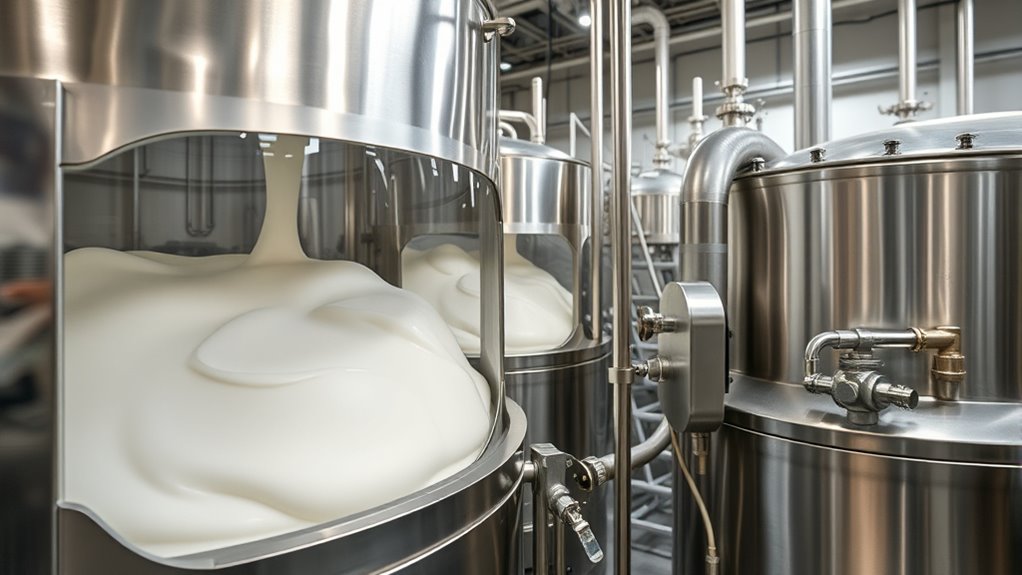
Recent advances in cream separation and recycling technologies are revolutionizing how industries handle cream waste. These innovations enable more efficient cream blending, reducing waste and maximizing resource use. New separation methods, such as membrane filtration, improve purity and recovery rates. Recycling techniques now allow you to reclaim cream from waste streams, cutting down on disposal needs. To deepen your understanding:
- Implementing high-efficiency separation equipment minimizes waste.
- Using advanced membrane technologies enhances cream recovery and quality.
- Integrating recycling processes supports sustainable waste reduction strategies.
Environmental and Economic Benefits of Waste Cream Utilization
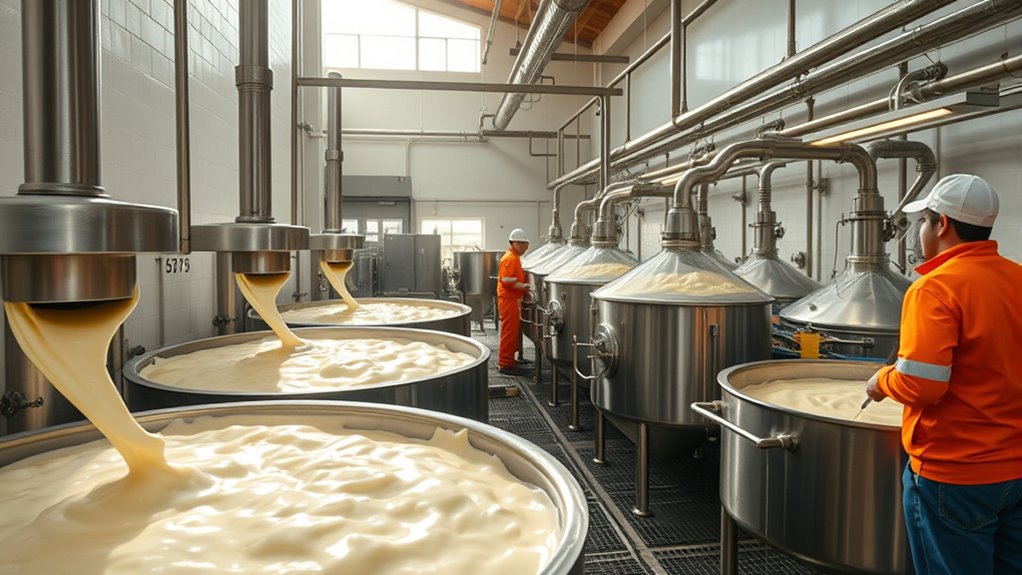
Utilizing cream waste offers significant environmental and economic advantages that can benefit your operations and the planet. It reduces disposal costs, minimizes waste, and promotes sustainability. Improving cream quality through waste recovery can open new markets, responding to increasing market demand for eco-friendly products. This approach not only lowers your carbon footprint but also boosts profitability by creating valuable by-products.
| Benefit | Impact | Example |
|---|---|---|
| Environmental | Reduces waste disposal and pollution | Less landfill use |
| Economic | Cuts costs, creates new revenue streams | Selling cream-based by-products |
| Market Demand | Meets consumer preference for sustainability | Eco-conscious consumers |
| Cream Quality | Enhances product purity and value | Higher-quality butter |
Future Trends in Sustainable Butter Manufacturing
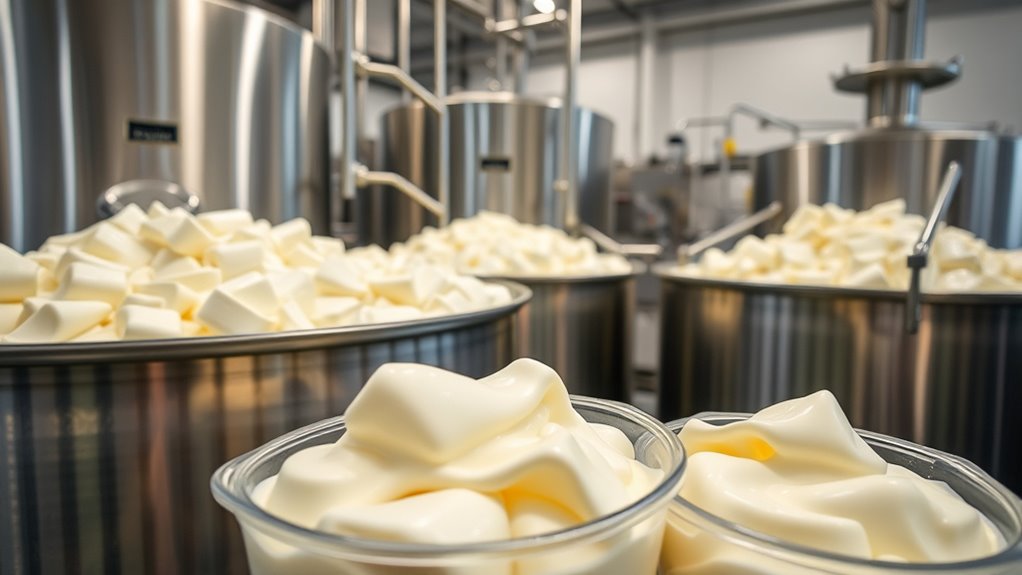
As consumer demand for eco-friendly products grows, the butter manufacturing industry is increasingly adopting sustainable practices. Future trends focus on enhancing cream quality while meeting market demand for eco-conscious products. You’ll see innovations such as:
- Use of renewable energy sources to lower carbon footprints.
- Advanced processing techniques to optimize cream quality from waste streams.
- Integration of circular economy models, turning waste cream into valuable ingredients.
- Implementing aura visualization techniques to monitor and improve process efficiency and employee well-being.
These trends aim to balance sustainability with product excellence, ensuring that cream quality remains high while fulfilling the market’s eco-friendly expectations. By adopting these practices, you position your butter plant as a leader in sustainable innovation, aligning with consumer values and securing long-term growth in a competitive market.
Frequently Asked Questions
What Are the Potential Health Risks of Using Waste Cream in Products?
Using waste cream in products can pose health risks if it contains microbial contamination or chemical residues. You might unknowingly introduce harmful bacteria or pathogens, leading to foodborne illnesses. Chemical residues from improper handling or processing could also cause allergic reactions or long-term health issues. To protect consumers, it’s essential to guarantee waste cream is thoroughly tested and sanitized before use, minimizing risks associated with contamination and residues.
How Does Waste Cream Impact the Overall Quality of Butter?
Using waste cream can affect the overall quality of butter by reducing cream purity, which may introduce impurities and affect the texture. It can also impact flavor consistency, leading to off-flavors or uneven taste. These changes compromise your product’s quality, making it less appealing to consumers. To maintain high standards, you should carefully monitor waste cream levels and guarantee proper processing to preserve cream purity and consistent flavor in your butter.
Are There Regulatory Standards for Waste Cream Disposal in Butter Plants?
They say, “Better safe than sorry,” and that’s true for waste cream disposal. You need to follow strict regulatory compliance and disposal guidelines in butter plants. These standards guarantee environmentally safe practices and prevent legal issues. While regulations vary by region, complying with local environmental agencies’ rules is essential. By doing so, you protect the environment, maintain product quality, and keep your operations running smoothly.
What Training Is Required for Staff Handling Waste Cream Recycling Processes?
You need to guarantee your staff understands handling safety and equipment maintenance when recycling waste cream. Proper training covers safe handling procedures, use of protective gear, and equipment operation to prevent accidents. Regularly update training to include safety protocols and maintenance routines. This way, your team minimizes risks, maintains equipment efficiently, and promotes a sustainable process that aligns with regulatory standards and best practices in butter plant operations.
Can Waste Cream Be Converted Into Other Value-Added Dairy Products?
You can convert waste cream into value-added dairy products through processes like cream fermentation and dairy valorization. These methods allow you to transform leftover cream into products such as cultured creams, cheese, or probiotic-rich items, enhancing sustainability. By utilizing waste cream creatively, you reduce waste and create new revenue streams. Implementing these techniques requires understanding fermentation processes and dairy valorization, which can boost your plant’s efficiency and environmental responsibility.
Conclusion
By embracing waste cream utilization, you can transform what seems like mere leftovers into a powerhouse of sustainability. Not only does this reduce environmental impact, but it also boosts your bottom line—turning waste into wealth. Imagine a future where butter plants lead the charge in eco-friendly practices, making a difference that’s bigger than you ever thought possible. Embrace these innovative solutions today and watch your sustainability efforts revolutionize the industry!





